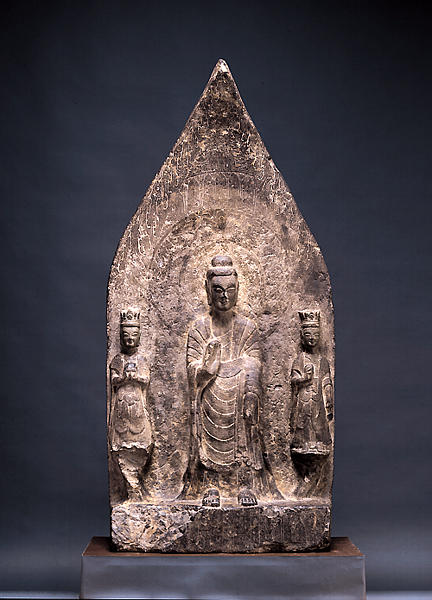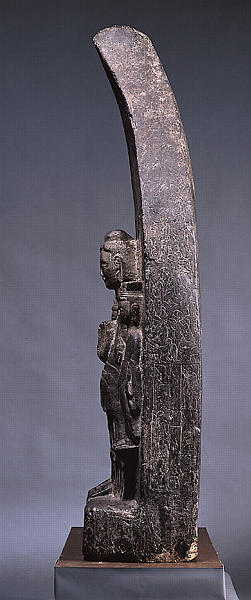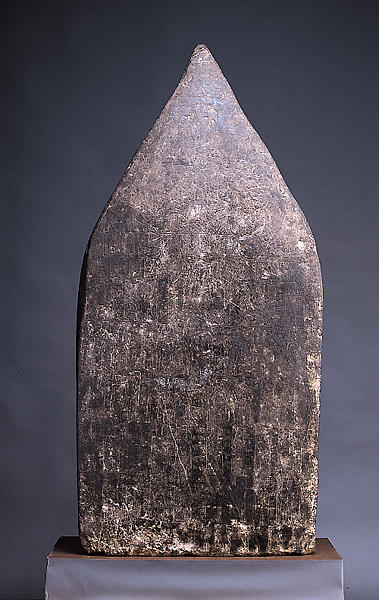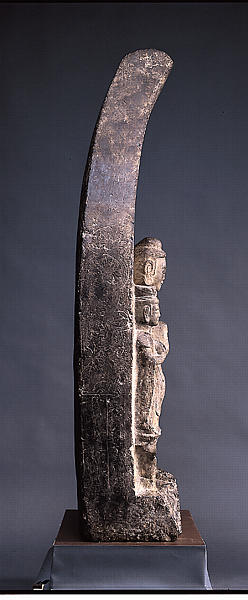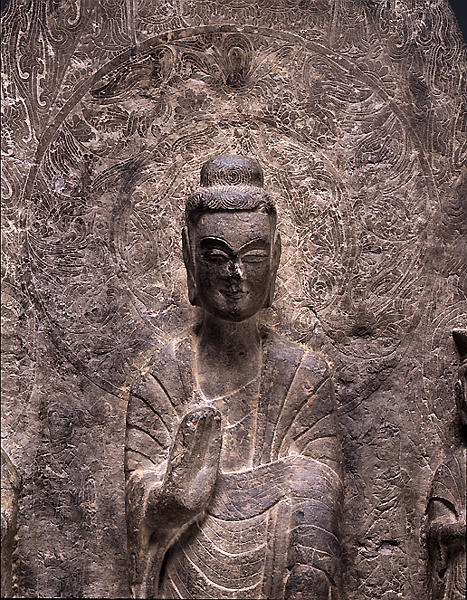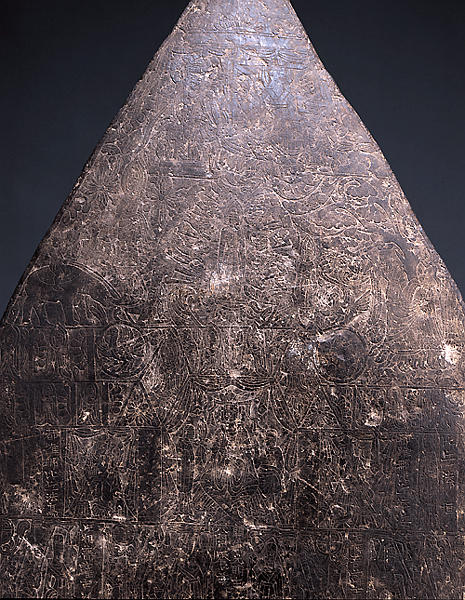仏三尊像
- 中国北部
- 6世紀第2四半期
- 石灰岩
- H-141 D-30 W-66
大きな火焔光背に包まれた一光三尊像である。中尊如来立像と左右の脇侍菩薩立像のみを高浮彫とし,光背や背面および両側面などはすべて線刻や浅い浮彫を施す。中尊如来立像は眉を陰刻線でくっきりと表し,口元に微かに笑みを浮かべている。袈裟は胸元を広く開けながら衣端を左前膊にかける中国式で,右手で施無畏印を示し腹部をやや突き出し気味に立つ。体躯表現は硬く,肉付けは単純で,衣文も平板で図案化されている。左右の脇侍菩薩像は中尊に比べると丸顔で表情も明るく,体つきも柔らかい。右像の天衣は正面で環に通しX字状に交差するが,左像分は環や交差の表現は曖昧である。菩薩におけるX字状の天衣や環飾の表現も,中国風な変化の一端である。右像は両手を合掌するように構えて持物(蓮蕾か)を持ち,左像は右手で蓮蕾様の持物,左手で水瓶を提げる。
Catalogue Entry
Carved from a single block of stone, this Buddhist stele presents a compelling devotional sculpture. A traditional triad of a Buddha with two bodhisattvas, their columnar figures powerfully modeled in high relief, emerges dramatically from the attenuated, pointed, leaf-shaped mandorla.
The large Buddha stands in the center planted firmly on his stout feet. His right hand is raised in the peace-giving gesture (abhaya mudra) while the left is lowered against his side.1 His robes spread over the shoulders and loop across the body in regularly spaced systematic folds. The robes fan out slightly at the bottom; some scalloped edges are vestiges of earlier sixth-century-style drapery cascades. The Buddha's head is framed by a circular aureole composed of two concentric rings, the outer filled with apsarases trailing scarves and the inner with interlaced lotus scrolls.
The two flanking bodhisattvas are smaller and supported by simplified lotus flower pedestals. Bodhisattvas, also enlightened beings, are distinguished from Buddhas by their crowns, jewelry, and more elaborate garments; here, both wear simple necklaces with scarves that loop down or criss-cross the front of the robes. Much smaller aureoles defined only by an incised raised band frame their heads.
All the surfaces of the front, back, sides, and base of the stele (excepting the sculptured triad) have been embellished with very shallow and delicately incised relief. The spaces between each bodhisattva and the Buddha contain an image of a monk standing on a lotus-flower pedestal and facing toward the Buddha. Defined in very low relief, these two monks refer to his youngest disciple, Ananda, and his oldest, Kashyapa. More deftly executed, the monk on the left seems to be Ananda and the one on the right, damaged and difficult to read, seems to be the older Kashyapa. On the front, above the triad, a band of stylized flames forms a border along both sides of the pointed top, enclosing a frieze of seven seated Buddhas alternating with single lotus flowers. The triangular space above the seven Buddhas holds two apsarases kneeling in homage to a small figure who raises up an incense burner to the Buddha figure floating above.
On each of the narrow sides of the stele, a dragon extends down from the top; complex and lushly intertwined floral vines issue from their toothy snouts. On the right side, these vines end with a pair of birds, probably peacocks, and on the left with a sprightly seated lion. Filling the space at the bottom of each side are unidentified monks and donors.
The lower two-thirds of the back of the stele also shows lines of donors, almost all identified by vertical columns of Chinese characters.2 Groups of different donors often contributed to the carving of a Buddhist stele to gain merit towards their eventual attainment of nirvana. Above the donors on the upper third of the stele, there are three main horizontal registers subdivided into a complex of images and stories. The register just above the donors is dominated by a cross-legged Maitreya flanked by two smaller bodhisattvas seated in the pensive pose. The next register shows a youthful standing bodhisattva surrounded by a ring of ravening long-necked beasts,3 and the last depicts the famous discourse between the Buddha of Wisdom, Manjushri, and the householder Vimilakirti. The apex of the stele is engraved with a long-legged bird and demiflorets.
The Shumei votive stele has sustained substantial damage over the years, visible in the missing left corner of the base, in the feet and the lotus pedestal of the left bodhisattva, and in the Buddha's raised hand and his nose. The stone's surface also has an overall soft appearance; consequently, the crisp sculptural modeling, particularly that defining the features of the bodhisattvas that is characteristic of this style, appears significantly muted, and the eyes are oddly shaped. In the technical studies, the stone shows both extensive microscopic pitting, a localized dissolution of the surface probably stemming from extended outdoor exposure, and areas of repair. The heads of the bodhisattvas from the crown to the neck and the right bodhisattva's feet and lotus pedestal top have been completely covered with a gray-brown material.4
This example shares stylistic features with at least two other stelae, in the Asian Art Museum of San Francisco and in the Reitberg Museum, Zurich.5 All have triads with three-dimensional columnar figures contrasting with shallow relief and incised imagery on the front, sides, and back surfaces of attenuated, pointed, leaf-shaped mandorlas. The Shumei votive stele stylistically bridges the shift from the more ascetic forms and layers of cascading drapery of the Northern Wei Dynasty (early sixth century) and the simple, more rounded forms seen in the Shumei celestial musician from the Northern Qi Dynasty (third quarter of the sixth century; cat. no. 123). Vestiges of the earlier style are visible in the drapery, while the bolder columnar figures, particularly the heads, point to the later, more sculptural style.
ALJ
1. In discussing this and the next image (cat. no. 123) , "right" and "left" are given from the viewer's perspective.
2. A preliminary translation of the donors names was completed by the London staff of Sotheby's and published in Sotheby's 1985, no. 245.
3. This scene may be an inaccurate representation of the jataka tale of Prince Mahasattva in which the hero gives his body to feed a starving family of tigers (Akiyama and Matsubara 1969, p. 207, pl. 10).
4. Without removing this gray/brown material used for repair, it is impossible to assess the shape and condition of the underlying sculptural form. For a full analysis of the condition of the stone and the repaired areas see the technical report written by Pieter Meyers, John Hirx, and John Twilley in volume two, forthcoming.
4. Asian Art Museum: see d'Argence and Turner 1967, p. 88, no. 32; Reitberg Museum: see L
